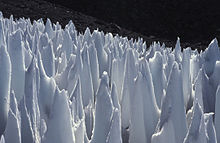Penitentes, or nieves penitentes (Spanish for "penitent snows"), are snow formations found at high altitudes. They take the form of elongated, thin blades of hardened snow or ice, closely spaced and pointing towards the general direction of the sun.[1]





The name comes from the resemblance of a field of penitentes to a crowd of kneeling people doing penance. The formation evokes the tall, pointed habits and hoods worn by brothers of religious orders in the Processions of Penance during Spanish Holy Week. In particular, the brothers' hats are tall, narrow, and white, with a pointed top.
These spires of snow and ice grow over all glaciated and snow-covered areas in the Dry Andes above 4,000 metres (13,000 ft).[2][3][4] They range in length from a few centimetres to over 5 metres (16 ft).[4][5]
Penitentes were first described in scientific literature by Charles Darwin in 1839.[6] On March 22, 1835, he had to squeeze his way through snowfields covered in penitentes near the Piuquenes Pass, on the way from Santiago de Chile to the Argentine city of Mendoza, and reported the local belief (continuing to the present day) that they were formed by the strong winds of the Andes.
Penitentes are tall, thin blades of hardened snow sculpted by the sun. As the sun hits the snow, it transforms it directly into vapor without melting it, through a process called sublimation. The ice vaporizes without turning into a liquid first. Initially smooth, the snow surface thus develops depressions, hills, and hollows as some regions sublimate faster than others. As the carved surfaces then continue to concentrate the sunlight, they help to speed up the process. This results in icy snow columns that look like towering spikes.[7] Louis Lliboutry noted that the key climatic condition behind the differential ablation that leads to the formation of penitentes is a dew point that remains below freezing. This combined with dry air will cause snow to sublimate. A mathematical model of the process has been developed by Betterton,[8] although the physical processes at the initial stage of penitente growth, from granular snow to micropenitentes, still remain unclear. The effect of penitentes on the energy balance of the snow surface, and therefore their effect on snow melt and water resources has also been studied.[9][10]
Penitentes up to 15 metres (49 ft) high are suggested to be present in the tropics zone on Europa, a satellite of Jupiter.[11][12] According to a 2017 study, NASA's New Horizons mission discovered penitentes hundreds of meters high on Pluto, likely composed primarily of methane ice deposited seasonally from Pluto's thin atmosphere.[13][14] The structures occupy a region named Tartarus Dorsa, a name that was formally accepted by the IAU in August 2017.[15]
{{cite book}}: |work= ignored (help)